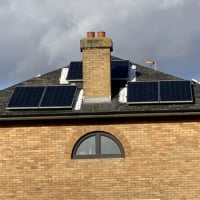We’d like to remind Forumites to please avoid political debate on the Forum.
This is to keep it a safe and useful space for MoneySaving discussions. Threads that are – or become – political in nature may be removed in line with the Forum’s rules. Thank you for your understanding.
The MSE Forum Team would like to wish you all a Merry Christmas. However, we know this time of year can be difficult for some. If you're struggling during the festive period, here's a list of organisations that might be able to help
📨 Have you signed up to the Forum's new Email Digest yet? Get a selection of trending threads sent straight to your inbox daily, weekly or monthly!
Has MSE helped you to save or reclaim money this year? Share your 2025 MoneySaving success stories!
Solar & Battery Advice
mnewtonuk
Posts: 15 Forumite





I have been looking at getting solar for some time now and have recently received the following quotes for a 10 panel + battery system:
10 x 435w panels (JA Solar/Trina/Jinko)
10 x 435w panels (JA Solar/Trina/Jinko)
Solis 4.6kW Hybrid inverter
Puredrive 5kWh battery
£9423
10 x 435w panels (JA Solar/Trina/Jinko)
Solis 4.6kW Hybrid inverter
Pylontech 2 x 3.5kWh battery
£9977
10 x 425w panels LONGi (LR5-54HTB-425M)
SolaX Power 3.68kW Hybrid inverter (X1-HYBRID-3.7-D)
SolaX Power 2 x 3kWh battery (T-BAT H 3.0)
£8598
These all include bird protection (our property backs onto a spinney) and all installation and certification costs.
I was wondering if they were sensible quotes, if one system is better than the other, or if anybody knows of alternatives that cover the Northamptonshire area?
I have an EV so my intention was to use IOG, charging up the car and battery on cheap rate overnight and exporting excess solar during the day.
I did also have a look at heatable and their kit looks good but was coming out at ~£11000 without bird protection which might be a bit too much for me.
£8598
These all include bird protection (our property backs onto a spinney) and all installation and certification costs.
I was wondering if they were sensible quotes, if one system is better than the other, or if anybody knows of alternatives that cover the Northamptonshire area?
I have an EV so my intention was to use IOG, charging up the car and battery on cheap rate overnight and exporting excess solar during the day.
I did also have a look at heatable and their kit looks good but was coming out at ~£11000 without bird protection which might be a bit too much for me.
1
Comments
-
Am I right that while on Octopus Go you only get 8p per kW exported?
https://octopus.energy/smart/outgoing/
Then your set up will generate about 4500kWh a year worth up to £360 (at 8p) depending on how much you export.0 -
I would be on Intelligent Octopus Go as my charger is compatible which allows you to use Outgoing Fixed currently at 15p/kWh.Newbie_John said:Am I right that while on Octopus Go you only get 8p per kW exported?
Then your set up will generate about 4500kWh a year worth up to £360 (at 8p) depending on how much you export.0 -
But you cannot combine it with Go:
https://octopus.energy/blog/outgoing-faqs/#goandoutgoing
you get the Lite version with 8p exports?0 -
"Intelligent Octopus Go" is a different import tariff to "Go".Newbie_John said:But you cannot combine it with Go:
you get the Lite version with 8p exports?
Intelligent Octopus Go can be combined with Outgoing Fixed at 15p/kWh whereas Go can only be combined Outgoing Fixed Lite at 8p/kWh.
I'd post a link but apparently I "have to be around for a little longer" before I can do that.
2 -
I wouldn't recommend any of the 3 quotes as they reek of extremely low end component brands purchased by installers keen on maximizing profit margin and not long term customer satisfaction.I hope you won't mind 3 questions?
1) What is your annual consumption?2) Does your roof have South/ West or East aspects?
3) Do you experience power blackouts?A few comments:
1) Heatable are a superb installer of high end kit (REA bifacial panels, Enphase microinverters). They are definitely more premium priced.
2) You don't need a battery to benefit from nighttime charging on the Agile or Flux tariffs, especially if your answer to Question 1) is < 4000kWh per annum.
(As an example, Flux has a 2-5am import window that costs ~15p, while paying ~18p per kWh exported)
3) For your perspective, a system with 10 X Sharp 425W black panels (30 year guarantee) + 10 SolarEdge optimizers + 1 SolarEdge 3.7kW inverter w/ 20 year warranty should cost no more than ~£5500 installed, including bird netting and G98. These are reputed brands with long track records of aftersales support for end users.
4) I would always recommend maximizing the # of panels installed over battery storage for a low consumption household. A rough guide is to add £300 per panel to the above price guide for every additional panel installed.
Hope this helps!- 10 x 400w LG Bifacial + 6 x 550W SHARP BiFacial + 2 x 570W SHARP Bifacial + 5kW SolarEdge Inverter + SolarEdge Optimizers. SE London.
- Triple aspect. (33% ENE.33% SSE. 34% WSW)
- Viessmann 200-W on Advanced Weather Comp. (The most efficient gas boiler sold)Feel free to DM me for help with any form of energy saving! Happy to help!1 -
Ok, cool, good to know.
So regarding the quotes (putting EV a side as you're not planning to charge it with solar):
1) If you export all 4500kWh - you earn £675 a year (15p per kWh)
2) If you use all of it you can save £1260 (28p per kWh)
So let's just say you land somewhere in the middle - £975
If you put £9k to a 4% saving account you will have £16208 after 15 years, after 15 years your solar system will save £14625 (assumed £975 a year).
Obviosuly many variables:
-price of elecitricty over next 15 years
-interest rates over next 15 years
-how much will you actually generate
-how much will you actually use
But with such long time to break even, I'm not entirely sure this plan makes sense?1 -
Thank you for the feedback.Screwdriva said:I wouldn't recommend any of the 3 quotes as they reek of extremely low end component brands purchased by installers keen on maximizing profit margin and not long term customer satisfaction.I hope you won't mind 3 questions?
1) What is your annual consumption?2) Does your roof have South/ West or East aspects?
3) Do you experience power blackouts?- My annual consumption before the EV was ~3500kWh. I've not had it long and currently I'm able to mainly charge it at work but I can't rely on that into the future. If I was charging at home I'd expect to use an additional 2500kWh per year.
- The roof aspect I'm looking at using faces SW.
- No, blackouts are not a significant concern.
I like the idea of battery storage but that might be a case of principle over what makes financial sense.
I have asked for the maximum number of panels that would fit on my roof to be quoted for and they've all come up with 10 panels so I believe that is all that would fit though it has only been done remotely.0 -
Yeah, so if you're using 3500kWh a year, that's 1750kWh during day light so we're talking about 20 years to break even.
There is a lot of other smaller bits that can improve these values - you can charge the battery at 8p at night and use it during the day in winter, you can charge your car during the day in summer for free, move between tarrifs when it makes more financial sense..
I think the battery makes a lot of sense, as altogether with Octopus Go it's reliable all year round - unlike solar panels that generate electricity only during the sunny days and most often when we're are at work.
Just from the financial point of view I always struggle to see many gains with this - it's such a long investment that it's very hard to predict which way it will go.
1 -
This is the hallmark of the type of installer I described earlier. Only an in-person survey can determine exactly how many panels will fit, once the roof dimensions are measured.mnewtonuk said: though it has only been done remotely.
I'd recommend using this calculator to yield an approximation on return on investment with an inexpensive 5kW battery/ without a battery.mnewtonuk said:I've not really looked at how Flux would work though I have noticed people swap between Agile and Flux depending on the season.
I like the idea of battery storage but that might be a case of principle over what makes financial sense.
Using blended Flux import/ export rates for both scenarios, I was able to achieve a <7 year return for a PV only system and a <10 year return for a PV + battery system. There are many assumptions built in (energy prices don't deviate higher/ lower, battery lasts for the full 10 year warranty period etc.).
I should state that South West roof aspects have outperformed all other aspects I see, as the 4-7pm generation from April to September is particularly lucrative on the Flux tariff.
Battery prices are falling and can always be added to a system after install, VAT free (this government got that one right)

- 10 x 400w LG Bifacial + 6 x 550W SHARP BiFacial + 2 x 570W SHARP Bifacial + 5kW SolarEdge Inverter + SolarEdge Optimizers. SE London.
- Triple aspect. (33% ENE.33% SSE. 34% WSW)
- Viessmann 200-W on Advanced Weather Comp. (The most efficient gas boiler sold)Feel free to DM me for help with any form of energy saving! Happy to help!0 -
My choice today would be a Sunsynk Ecco hybrid inverter & Fogstar batteries.
https://www.sunsynk.org/5kw-hybrid-inverter
https://www.fogstar.co.uk/collections/solar-battery-storage/products/server-rack-battery-48v-5-12kwh
4kWp (black/black) - Sofar Inverter - SSE(141°) - 30° pitch - North LincsInstalled June 2013 - PVGIS = 3400Sofar ME3000SP Inverter & 5 x Pylontech US2000B Plus & 3 x US2000C Batteries - 19.2kWh2
Confirm your email address to Create Threads and Reply

Categories
- All Categories
- 352.9K Banking & Borrowing
- 253.9K Reduce Debt & Boost Income
- 454.7K Spending & Discounts
- 246K Work, Benefits & Business
- 602.1K Mortgages, Homes & Bills
- 177.8K Life & Family
- 259.9K Travel & Transport
- 1.5M Hobbies & Leisure
- 16K Discuss & Feedback
- 37.7K Read-Only Boards

